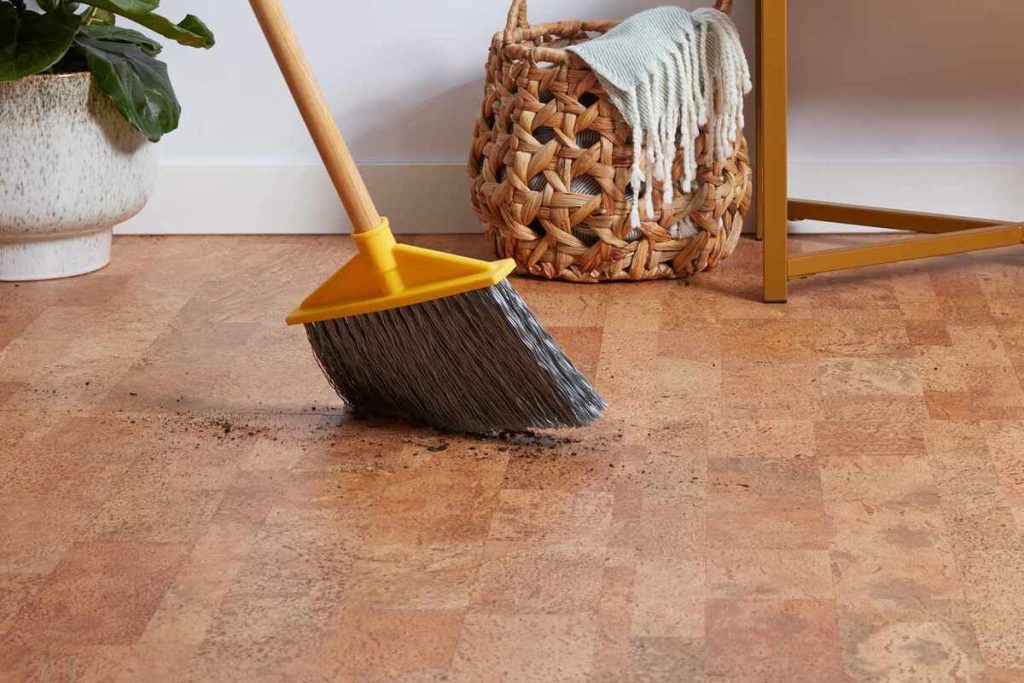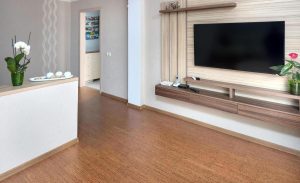Cork flooring is a home design secret, offering cloud-like comfort and lasting 40+ years. Its cushiony feel is gentle on joints, perfect for long periods of standing. Cork comes from the bark of cork oak trees, harvested sustainably every 9 years without harming the tree, which can live up to 250 years. Beyond comfort, cork absorbs sound, insulates well (R-value 1.125), resists mould, and repels allergens like dust and dander better than other floors. Curious about its durability, style, or how it compares to other flooring? Cork combines comfort, sustainability, and modern design in one unique option.
Why Cork Flooring Feels Like Walking on Clouds
Picture walking on a surface that hugs your feet with every step. Modern cork flooring gives you exactly that experience. Cork creates a cushioned feeling that changes how you move around your home, unlike traditional hard surfaces.
Softness and bounce underfoot
Cork’s cloud-like comfort comes from its extraordinary cellular structure. Each piece contains millions of tiny air-filled cells that naturally compress under pressure and bounce back to shape. You’ll feel a unique “bounce back” effect with every step.
The first time people walk on cork, they’re often amazed by how it feels under their feet. Your joints will thank you too – the material’s natural flex reduces strain by a lot. Walking on cork feels like stepping on a gently springy surface instead of a hard floor. Cork’s elasticity does more than just feel good – it helps protect your belongings. Drop a dish or glass, and cork’s forgiving nature might make it bounce instead of break.

Ideal for standing areas like kitchens
Cork flooring is a game-changer for anyone who spends hours in the kitchen. Your back, legs, and feet won’t tire as quickly when you stand on its naturally soft surface. Unlike tile or stone that gets uncomfortable fast, cork stays warm and cushioned. Home chefs and cooking enthusiasts love this feature during long kitchen sessions. You get comfort like carpet but with hard floor practicality.
People with pain syndromes, migraines, or back and hip problems find real relief with cork flooring.
Safe for kids and elderly
Families with multiple generations under one roof should think about cork flooring. Falls are less likely to cause serious injury because the material provides a softer landing. This makes cork perfect for children’s playrooms and homes where older adults live.
Cork gives you better traction than many hard floors, so it’s naturally slip-resistant. This feature, combined with its shock-absorbing qualities, creates a safer environment that reduces both fall risks and injuries. Quality cork flooring handles high traffic areas well while keeping its cushioned feel, which makes it surprisingly tough.
The Hidden Benefits of Cork Flooring
Modern cork flooring offers several amazing benefits beyond its cloud-like comfort that you might not notice right away.
Natural sound insulation
Cork’s cellular structure makes it a natural acoustic insulator. Its porous composition with millions of air-filled cells helps absorb sound waves and reduce impact noise. Laboratory tests have shown that cork panels exhibit high sound absorption coefficients, demonstrating their effectiveness in dampening footstep noise and vibrations. This makes cork flooring an excellent choice for multi-level homes, apartments, or condos where quiet matters.
Thermal insulation and energy savings
Cork’s impressive thermal properties match high-grade exterior Styrofoam with an R-value of 3.60 per cubic inch. This natural insulation keeps room temperatures steady throughout the year. People who installed cork flooring in cold basements saw temperature increases up to 7 degrees Celsius (12-13 degrees Fahrenheit). The thermal efficiency can cut heating and cooling costs by up to 30%.

Hypoallergenic and antimicrobial properties
Cork contains suberin, a natural waxy substance that fights against:
- Mould and mildew growth
- Bacteria proliferation
- Insects and pests
Tests show cork’s powerful antibacterial properties can reduce Staphylococcus aureus bacteria by nearly 100% (96.93%) after just 90 minutes of exposure. Cork doesn’t trap dust or shed microfibers, which makes it great for people with allergies.
Eco-friendly and renewable material
Cork harvesting stands out as one of the most sustainable processes. Workers only remove the bark, which leaves the cork oak trees unharmed. The bark grows back completely in about nine years, and each tree can provide bark multiple times during its 150+ year life. Cork flooring is 100% sustainable and helps reduce atmospheric carbon. The production process is 95% energy self-sufficient, making cork one of the most environmentally responsible flooring options you can choose.
Is Cork Flooring Durable and Easy to Maintain?
Modern cork flooring combines a soft feel with amazing durability that homeowners love for both comfort and practicality.
- Resistance to wear and tear
A waxy substance called suberin makes cork naturally waterproof, fire-resistant, and antimicrobial. This special material bounces back to its original shape after being compressed. You can remove small dents from furniture by applying hot steam with wet towels. - How long cork flooring lasts
Well-maintained cork floors can last over 40 years. Beautiful cork installations from 1880-1940 still work great in many European buildings today. The lifespan depends on cork quality, finish type, proper installation, and regular care. - Cleaning and sealing tips
Daily care basics:
– Use soft bristle attachments to sweep or vacuum (no beater bars)
– Use a slightly damp mop with pH-neutral cleaner
– Clean spills right away to avoid stains
Your cork floors will need new sealing every 5-10 years based on foot traffic. Water-based polyurethane finishes like Loba 2K Supra AT give the best protection with 2-3 coats. - Can cork be refinished?
Solid cork flooring can definitely be refinished. You can sand away imperfections and add new sealant. The cork layer in engineered flooring is too thin for complete refinishing. Light buffing and recoating works great to fix minor surface problems.

What to Consider Before Choosing Cork
Cork flooring has many benefits, but you need to know its drawbacks to make the right choice for your home.
Scratches and dents from pets or furniture
The softness of cork is both good and bad news. This material bounces back well but sharp objects and heavy furniture can damage it. Pet owners should watch out – dog and cat claws will leave scratches on cork surfaces. You can reduce damage by keeping your pets’ nails trimmed and placing furniture coasters under heavy items. Your furniture should be moved slightly every few months to avoid lasting dents.
Water resistance vs waterproofing
Today’s cork floors resist water but are not completely waterproof. Spills that penetrate unsealed surfaces may cause warping or colour changes. To maintain protection, cork floors should be resealed every five to seven years.
Colour fading in sunlight
Sunlight poses a real challenge since cork is sensitive to UV rays. Floor sections may fade unevenly with prolonged sun exposure, sometimes within the first year. To protect your flooring, use curtains or blinds in sunny areas, or consider fade-resistant cork products designed for high UV exposure.
Cost compared to other flooring types
Cork flooring runs between $3-$20 per square foot based on quality. Installation costs add $2-$4 per square foot for floating floors, while glue-down methods can double these costs. Cork costs more than:
- Vinyl/laminate ($2-$14/sq ft)
- Carpet ($3.50-$11/sq ft)
But less than:
- Tile ($15-$20/sq ft)
Conclusion
Cork flooring offers cloud-like comfort and lasts 40+ years. It cushions joints, absorbs sound, insulates, and stays hypoallergenic, making it ideal for kitchens, workspaces, or any standing areas. Resilient and eco-friendly, cork is harvested sustainably without harming trees. Proper sealing protects it for decades, and while pricier than vinyl or laminate, its comfort and natural appeal make it worth it. Cork strikes a perfect balance between carpet and hard flooring, providing comfort, quiet, and a unique natural look. Contact us for a quote, and we’ll handle the installation for you.
